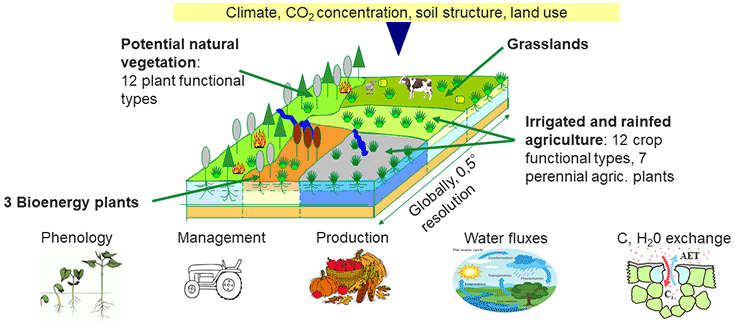Dynamic modelling of the water-food-energy-ecosystem nexus with LPJmL
LPJmL is a state-of-the-art dynamic, global agro-ecosystem and water model. LPJmL simulates, in a consistent and process-based framework and at the global scale, water, carbon and nitrogen fluxes and stocks as well as the growth of natural vegetation, food crops and bioenergy crops.

The Chair of Nexus Research develops and uses the model LPJmL in close cooperation with the Potsdam Institute for Climate Impact Research.
Spatial resolution: LPJmL has a variable spatial resolution, but most applications have been done at 0,5 degrees.
Regional applications: Most applications have been performed at the global level, but large regional applications in Africa, Asia, Amazonas and the Mediterranean region have been successfully performed as well. In our group, we have the ambition to both applied LPJmL at global and large-scale, and settle the mode up for Germany and Bavaria.
Simulated processes (selection): photosynthesis, phenology, GPP, NPP, carbon storage in vegetation, carbon allocation, biome shifts, crop and bioenergy harvests, sowing dates, NPP, GPP, fire, soil evaporation, plant transpiration, water use efficiency, irrigation water requirements, river discharge, soil water, water stress in plants, water reservoir operation, CO2-fertilization effect, agricultural management, permafrost dynamics. See here a list of represented natural ecosystems. See here a list of food and bioenergy crops.
Coupling with other models: LPJmL does not have a dynamic atmosphere, nor dynamic allocation of land use patterns. It rather uses climate and land use inputs. However, LPJmL has been coupled with climate models in the past such as CLIMBER. Also, in order to account for socio-economic variables, including land use, LPJmL has been coupled to other models, such as MagPIE and IMAGE. In our chair, we intent to couple LPJmL with an economic model to account for global trade of goods.
Engagement in model intercomparison projects: LPJmL is part of the models that participate in the ISI-MIP and AgMIP / GGCMI efforts.
See key model publications here: https://www.pik-potsdam.de/en/institute/departments/activities/biosphere-water-modelling/lpjml/key-publications
Source code: The source code of the model is available under the AGPLv3 license at https://github.com/PIK-LPJmL/LPJmL
See also the LPJmL site at PIK: https://www.pik-potsdam.de/en/institute/departments/activities/biosphere-water-modelling/lpjml
The code community meeting point: https://zenodo.org/communities/lpjml

